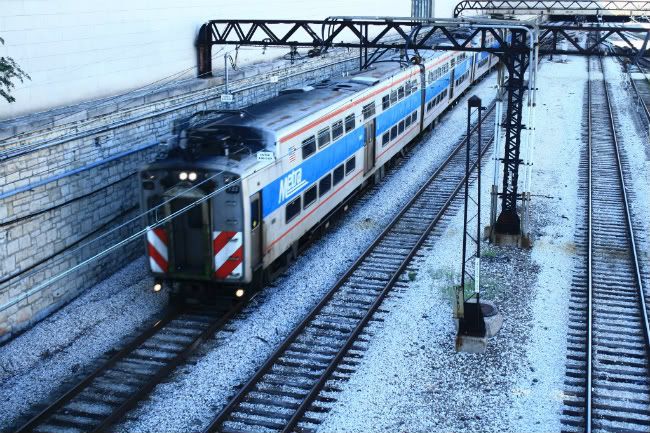 I recently got back from my long rail trip, and I have a large stockpile of photos to use in this column now! I'll try not to use too many of them at once, but today's photo is from Chicago. I had eight hours to kill between getting off the Texas Eagle and getting on the Lake Shore Limited, and I had never actually walked around Chicago before even though I had been there before, so I decided to go walking around. My first stop was the Willis Tower, formerly the Sears Tower. The wait to get to the top was almost three hours, but it was either that or waiting for my train, so I waited in line. After the Willis Tower, I kept walking east until I got to Lake Michigan. On the way there, the street crosses the Metra Electric District, formerly run by the Illinois Central. I stopped there for a few minutes, and snapped this photo:
I recently got back from my long rail trip, and I have a large stockpile of photos to use in this column now! I'll try not to use too many of them at once, but today's photo is from Chicago. I had eight hours to kill between getting off the Texas Eagle and getting on the Lake Shore Limited, and I had never actually walked around Chicago before even though I had been there before, so I decided to go walking around. My first stop was the Willis Tower, formerly the Sears Tower. The wait to get to the top was almost three hours, but it was either that or waiting for my train, so I waited in line. After the Willis Tower, I kept walking east until I got to Lake Michigan. On the way there, the street crosses the Metra Electric District, formerly run by the Illinois Central. I stopped there for a few minutes, and snapped this photo:
This train had just left from Millenium Station, formerly Randolph Street Station. I don't know where it was going, because there are three electric lines operated by Metra. Chicago, South Shore, and South Bend Railroad (South Shore Line for short) also uses these tracks, it runs east to South Bend, Indiana.
Illinois Central built this line. IC ran south from Chicago all the way to New Orleans, running such trains as the all first class Panama Limited. Amtrak runs this route now, out of Chicago's Union Station, and calls the train City of New Orleans, named after a coach version of the Panama Limited. In the 1920s, the Illinois Central and the city of Chicago decided to electrify the IC's commuter lines. The South Shore Line up to this point did not have a way into Chicago, it met up with the IC south of Chicago where you had to change trains. The electrification project gave the interurban direct access to Chicago, and to this day the railroad still runs electric commuter trains out of this station. The wires carry 1500 volts of direct current.
I'm a big fan of electric trains. I personally don't think we have enough of them anymore in this country. There was a time when every city had an electric streetcar system, and electric interurban lines connected cities with each other. Only one interurban line, the South Shore Line, is left, and it's not much of an interurban anymore. Some streetcar lines still exist as light rail or historic streetcar lines, in Boston, Philadelphia, and San Francisco, to name a few. Electric mainlines have also disappeared across the country for several reasons. Some, like the Boston & Maine's electric trackage, were built through long tunnels to help keep smoke from steam engines building up in the tunnels. When diesels grew in popularity, these electric districts were no longer needed. Another popular reason for electrification was to help in mountain ranges. Again, as diesels came out, these disappeared. They also disappeared in mergers, when the electric district became a very small part of a very large railroad. The larger railroad wanted to standardize things as much as possible, and that meant the electrics had to go. In the case of the Milwaukee Road, the two electric districts were taken down because the railroad invested a ton of money in brand new diesels, which eventually put the railroad out of business.
Some electrified lines still exist. Most, like the one in Chicago, only serve commuter operations. Pennsylvania Railroad and New York Central electrified their tunnels into Manhattan because the city of New York required it as the result of a deadly crash in the smoky New York Central tunnels. That law is still in effect and all trains into Manhattan are powered electrically today. Amtrak runs electric trains between Boston and Washington and between Philadelphia and Harrisburg.
I think one of the reasons electricity failed in this country is because of a lack of standardization, and because it was not used extensively enough. The Pennsylvania Railroad electrified more track than any other railroad, and every mile of those wires is still up and used daily, and has since expanded to Boston. The New Haven Railroad electrified between New York and New Haven, and some branch lines. One branch still has wires. However, this was a huge investment and it was all standardized. PRR used 12,000 volts AC and New Haven used 11,000 volts AC, different voltages, but compatible with each other. However, other systems were too small to be practical for larger railroads and were not standardized. If there was a standard voltage, like there is a standard gauge for rail spacing, that would have prompted electrification to grow and join up with other electrified districts, creating a strong, reliable, and compatible electrified system in this country, just as the rail system is all compatible with each other no matter what railroad you're on.

No comments:
Post a Comment